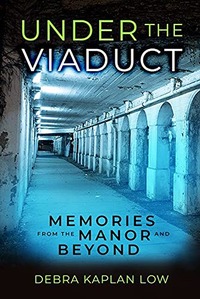Book Review: Under the Viaduct: Memories from the Manor and Beyond.
 Monday, September 20, 2021 at 11:41AM
Monday, September 20, 2021 at 11:41AM 
Under the Viaduct: Memories from the Manor and Beyond. Debra Kaplan Low, Book Street Press, September 30, 2021, Paperback and eBook, 155 pages.
Review by Marcie Hill.
It was a joy to read Under the Viaduct: Memories from the Manor and Beyond by Debra Kaplan Low. In addition to sharing stories about her life under the viaduct, Debra gives readers history lessons about Chicago, Jewish traditions, race in Chicago, and more. Her sense of humor and creative wordplay add an extra level of engagement to this captivating read. As I read this book, I felt like I knew Debra personally.
Debra describes Jeffrey Manor as a “paradise within the confines of a neighborhood.” It was refreshing to read firsthand accounts about the manor’s people, places, and activities that shaped Debra’s life. The residents were close because of their shared housing, experiences, and relationships. They didn’t have a lot of money, but they had each other. They knew intimate details about each other, supported each other, and created bonds that remain strong today. The viaduct played a major role in creating this close-knit community.
To the average person, viaducts are structures that support railroads. In the manor, the viaduct was the great divider. It divided the community into north and south regions, separating people based on class and income. The north side residents were “more well-educated, wealthier, professional white folks” that lived in single-family homes. Residents in the south manor were blue and white-collar workers that lived in “almost identical and very affordable duplex and row houses.” This viaduct is a physical reflection of the invisible barrier that separates Chicago’s north and south sides today. The north side has mostly white residents with higher incomes, better schools, high-value housing options, retailers and grocery stores within walking distance, and financial support from political officials. Most of the south side is occupied by middle class, working-class and low-income people of diverse races, lower home values, poorer schools, food, and pharmacy deserts, and has received little financial support from elected officials.
I learned about Jewish values, traditions, and ceremonies. Debra’s description of some of their events and her journey to finding her faith was hilarious. She was open about her father’s anger and emotional issues, her mother’s tolerance of his behavior, and how the family north of the viaduct treated her family. It was painful to read about the physical and emotional health challenges Manorites experienced because of exposure to deadly toxins near their homes. Some of them died. Despite this, the words used to describe the life after college for Boomers, as well as the irony of “Kosher Jews eating pork,” and the fact that her mother was the first Jewish member of the St. Stephens Episcopal Women’s Circle, brought smiles and laughter.
The book included several things about race in Chicago and beyond based on personal experiences, not just research. I didn’t know that people hung signs that read “No Jews Allowed.” I didn’t know that German Jews were treated differently than European Jews. Bowen High School had a diverse student population. I thought only white people could live and attend school in that area before the 1970s. I knew about the “white flight” from big cities, but I didn’t know when it happened. Debra noted that it began in the late 1960s and ended in the early 1970s. “The manor was entirely white until 1967,” but most residents had moved by 1972. I learned the origin of slumlords, the name given to landlords who charged high rents for crappy housing and treated their tenants poorly.
As a native South Sider, I related to Debra’s south side pride and neighborhood loyalty. Her Manor pride and loyalty remain today, even though she lives in Arizona. Readers will learn about Debra personally and as an author when they read Under the Viaduct: Memories from the Manor and Beyond.

Reader Comments